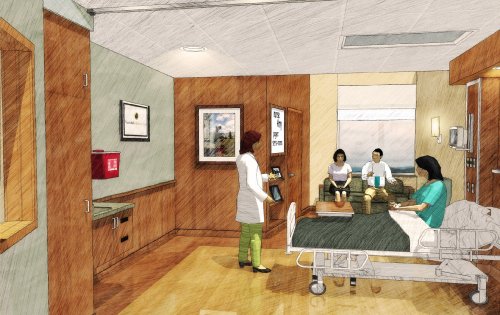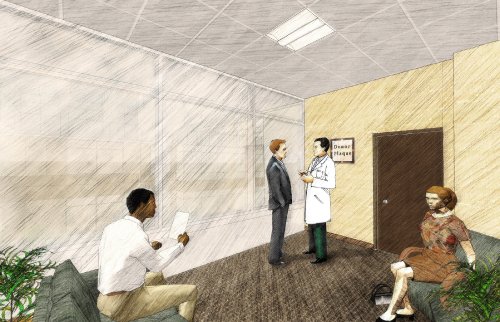
Patient rooms in the new Critical Care Tower will provide more space for family members. (courtesy Earl Swensson Associates)
Tower’s design meets needs of patients, care team
With the move to the Critical Care Tower only seven months away, nurse managers in the Medical, Neurological and Surgical intensive care units are preparing to move their nursing staff into a space uniquely designed to meet their needs.
“This was a tremendous opportunity to create a nurse- and patient-friendly environment and help standardize and simplify care,” said Pam Jones, M.S.N., R.N., executive hospital director for Patient Care Services and Nursing, Vanderbilt University Hospital.
Increased square footage in patient rooms in the new tower will provide more space for family members and equipment and for nurses to provide care.
The biggest change for the SICU will be transitioning from mostly semi-private to all private rooms, said Mike Daly, M.S.N., R.N., manager of patient care services.
“Our nurses will be able to see patients and document their care without feeling like they're in the patient or family space. The additional space for family members will allow them to stay with patients more frequently. The staff are somewhat nervous about changes related to this, but we know that patients recover most effectively with family around,” he said.

Dedicated meeting rooms for patient families or staff are part of the new tower’s design. (courtesy Earl Swensson Associates)
Some new features of the Critical Care Tower promote staff health and wellness. Each unit will have three bariatric rooms equipped with ceiling lifts that will allow staff to move heavy patients ergonomically. There is also a quiet room on each unit with plush furniture that staff can use as a retreat for stress relief.
“In our unit, we have a lot of patients that we withdraw support on,” said Julie Foss, M.S.N., R.N., manager of patient care services in the MICU.
“And in the midst of that, you may need five minutes to renew yourself. Any staff member or physician can go into the space and have time for renewal.”
Foss said her staff is most excited about expanded documentation space. Their computers currently clutter the halls, but in the Critical Care Tower, there will be a computer by each bedside, and an alcove between every two rooms will have a computer and a window for patient observation.
Jones said that significant planning went into ensuring there was ample documentation space.
“We worked hard to ensure efficient access to documentation and support systems so nurses can spend as much time as possible at the bedside. Documentation systems are a crucial part of efficient nursing care, and a great deal of thought was given to layout and availability,” she said.
All units will have call rooms, making physician access faster and easier, and dedicated conference rooms for meetings with family or staff.
Each unit will also have radiology rooms and blood gas labs, features that the Neuro ICU is looking forward to, said Cindy Childress, M.S.N., R.N., interim manager of patient care services.
“These amenities will ensure that results are posted to the medical record much quicker,” she said. “We're also excited about the new equipment and monitors.”
All managers say staff input was key in the planning process. In the Neuro ICU, Childress posted floor plans and asked for feedback, arranged construction tours so staff could visualize the new space, and gave updates as decisions were made.
Foss said that MICU staff embraced being a part of the planning process.
“They had really good ideas because they're at the bedside and can point out things that managers, educators and administrators haven't considered,” she said.
To prepare for the Nov. 14 move, a five-hour test run in the new unit, called “A Day in the Life,” will be held Oct. 15 and a mock move will be held Oct. 24.
“The goal will be to stress test the system and work out the new processes in a controlled environment so we can make changes without critically ill patients involved,” said Ashley Staniewski, M.S.N., R.N., assistant manager for patient care services in the SICU.
“We're practicing the day-to-day things, not what to do if a tornado comes, so we can nail the processes down. We don't want to troubleshoot with an actual patient.”
The managers agreed that nurses were excited but anxious about moving.
“The biggest challenge is not moving the patients,” Daly said. “The biggest challenge is moving the employees and keeping them satisfied and happy. When we get there, we want them to be set up in a way that makes them more capable of doing an excellent job. We're excited but appropriately concerned. We want it to be right.”













